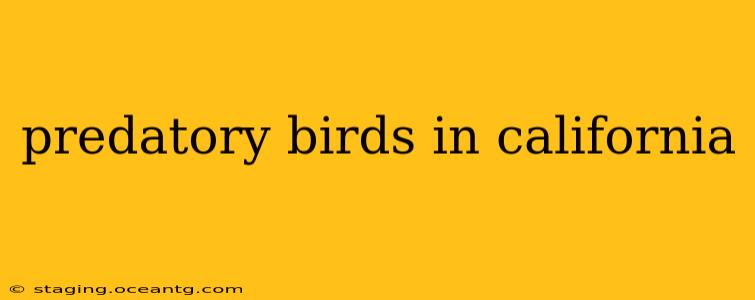California, with its diverse ecosystems ranging from coastal wetlands to mountainous forests and arid deserts, boasts a rich tapestry of avian life. Among these feathered inhabitants, predatory birds, or raptors, hold a significant place, playing crucial roles in maintaining ecological balance. This comprehensive guide explores the fascinating world of predatory birds found in the Golden State, delving into their characteristics, habitats, and conservation status.
What are the most common predatory birds in California?
California's varied landscapes support a remarkable diversity of raptors. Some of the most commonly encountered include:
-
Red-tailed Hawk: Arguably the most ubiquitous raptor in California, the Red-tailed Hawk is easily recognizable by its reddish tail and broad wings. They are highly adaptable and can be found in a wide range of habitats, from grasslands to forests to urban areas.
-
Cooper's Hawk: This agile and powerful hawk is a skilled hunter of smaller birds, often seen in wooded areas. Their dark plumage and relatively short, rounded wings distinguish them from other hawks.
-
Sharp-shinned Hawk: Smaller than the Cooper's Hawk, the Sharp-shinned Hawk is a swift and acrobatic hunter specializing in pursuing smaller birds. Their slender build and narrow wings are key identifiers.
-
Northern Harrier: This marsh hawk is easily identified by its distinctive flight pattern – a slow, graceful flapping interspersed with hovering. They primarily hunt in grasslands, marshes, and other open areas.
-
American Kestrel: The smallest falcon in North America, the American Kestrel is a colorful bird with a rusty-red back and a distinctive facial pattern. They are frequently seen perched on utility poles or other elevated vantage points.
-
Golden Eagle: A majestic and powerful bird of prey, the Golden Eagle is found in mountainous regions of California, often nesting on cliffs. Their size and dark brown plumage with a golden-brown nape make them easily identifiable.
What are some of the less common predatory birds found in California?
While the aforementioned raptors are frequently sighted, California also hosts several less common, yet equally impressive, predatory birds:
-
Peregrine Falcon: Known for its incredible speed, the Peregrine Falcon is a rare but spectacular sight in California. They typically nest on cliffs and rocky outcrops.
-
Prairie Falcon: This falcon prefers open habitats, including deserts and grasslands. They are less common than the American Kestrel but still can be found in suitable areas.
-
Bald Eagle: While once endangered, Bald Eagles are making a strong comeback in California, often found near large bodies of water.
-
Burrowing Owl: Unlike the other raptors listed, this owl is a ground-dwelling bird often inhabiting burrows in grasslands and open fields.
Where can I see predatory birds in California?
The best locations for observing predatory birds in California depend largely on the species you're hoping to see. However, some excellent locations include:
-
National Parks and Wildlife Refuges: These protected areas often offer exceptional opportunities for wildlife viewing, including raptors.
-
Coastal areas: Areas such as the California coast provide habitats for coastal raptors.
-
Mountain ranges: Higher elevations are home to Golden Eagles and other high-altitude raptors.
-
Agricultural areas: Open fields and grasslands attract several species, including Northern Harriers.
What is the best time of year to see predatory birds in California?
Many migratory raptors pass through California during the fall and spring migrations. However, resident species can be seen year-round. The best time to observe raptors often depends on the specific species and their breeding and migratory patterns.
Are predatory birds in California endangered?
The conservation status of California's predatory birds varies greatly depending on the species. Some, like the Bald Eagle, have made remarkable recoveries from near-extinction, while others continue to face challenges from habitat loss, pesticide use, and other threats. Many conservation organizations actively work to protect these magnificent birds.
What should I do if I see an injured predatory bird in California?
If you encounter an injured or distressed predatory bird, do not attempt to handle it yourself. Instead, contact a local wildlife rehabilitation center or animal control agency. They have the expertise and resources to provide appropriate care.
This exploration into California's predatory birds offers a glimpse into the rich biodiversity of the state. By understanding their habits, habitats, and conservation needs, we can better appreciate and protect these magnificent creatures and the vital ecological roles they play. Remember to always observe wildlife responsibly, maintaining a safe distance and minimizing disturbance.
